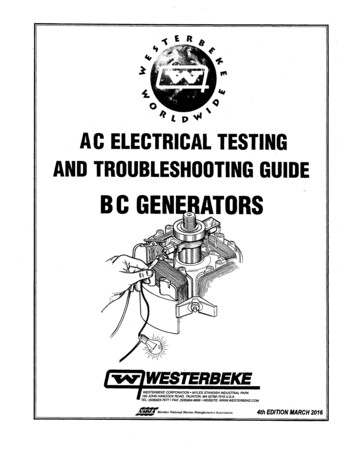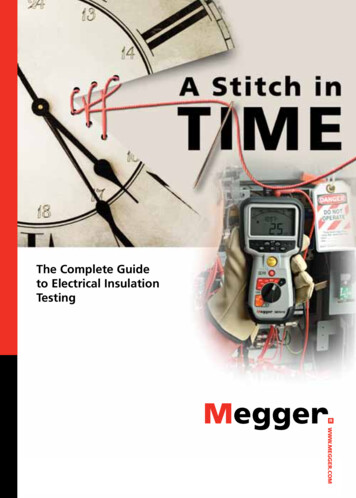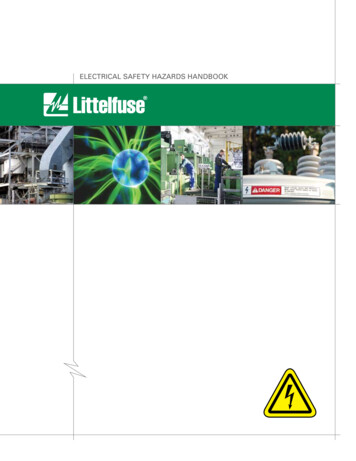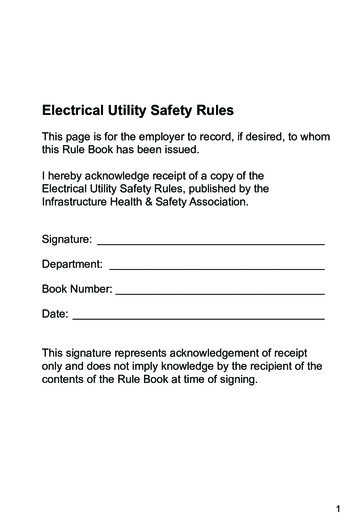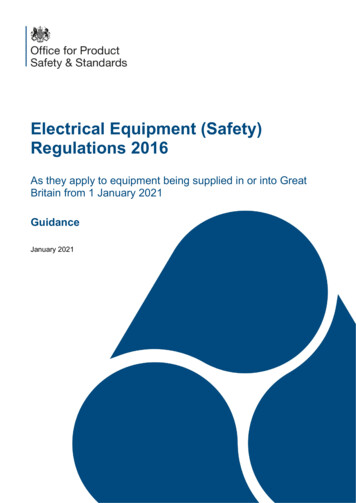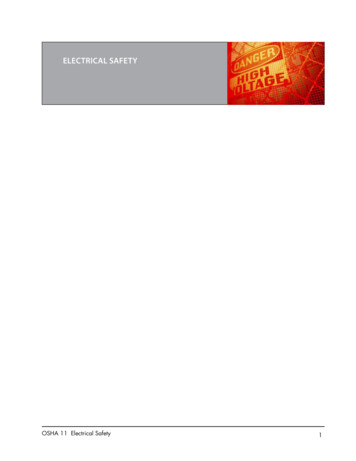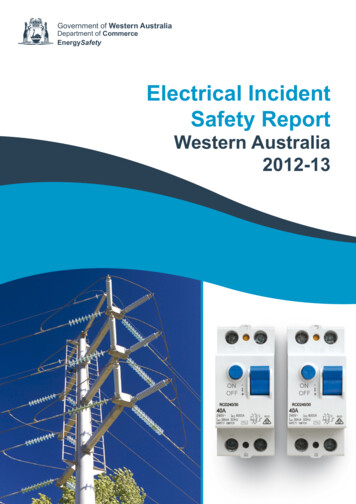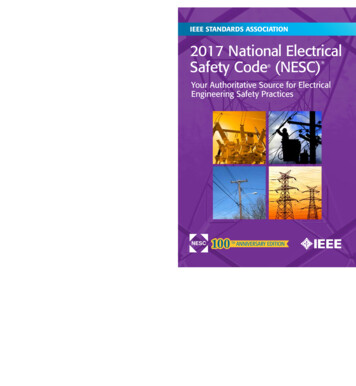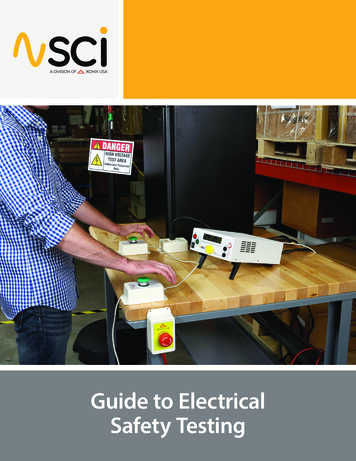
Transcription
Guide to ElectricalSafety Testinghipot.com
GENERAL INFORMATIONWhy Test?There are four main reasons why you should safety test your products prior to shipment1. SafetyEnsure that the product is not going to pose a hazard to the end user.2. QualityDetect workmanship defects and prevent faulty components from being installed.3. Cost ControlIdentify production problems before a product is shipped, preventing costly recalls.4. LiabilityPrevent product liability suits because the responsibility of performing electrical safety testsultimately rests on the manufacturerNRTLs (Nationally Recognized Testing Laboratories) set standards outlining tests that must be performed on a product beforeit’s considered safe for the consumer market. NRTLs implement and enforce electrical safety testing to protect consumers froma potentially fatal electric shock.NRTL Examples: Underwriters Laboratories (UL - United States), TUV Rheinland (Germany), Canadian Standards Association(CSA - Canada), ETL (Intertek - United States) and CCC (China Compulsory Certification - China)NRTL standards dictate that electrical products incorporate two lines of defense to protect theuser from electrical shockInsulationSafety Grounds Separates power lines from low voltage circuits. Separates power lines from isolated power supplies. Allow dangerous fault currents to return tosystem ground. Isolates input power from the chassis or case of anelectrical device. Safeguards against fire. Enables circuit breakers to open. Protects against damage to electrical equipment.Electrical products can be classified according to insulation typeClass I Products Terminate in 3 prong line cord (line, neutral and ground). Ground prong connects to product chassis. Safety through basic insulation and proper grounding.Class II Products Double insulated products. Terminate in 2 prong line cord (line and neutral). Safety through dual layer of insulation.2Safety Made Simple
GENERAL INFORMATIONNRTL standards generally specify two separate testing categoriesType Test Performed as a laboratory or prototype test Done on sample basis Used to detect defects in product design More rigorous testingProduction Line Test Performed on 100% of products on the production line. Used to detect manufacturing or workmanship defectsAs a manufacturer or test operator, it’s up to you to ensure you have the proper knowledge andtraining to use high voltage equipment.Before working with an electrical safety test station, you need to make sure you are a qualified operator according to OSHAguidelines1.Occupational Safety and Health AdministrationAn agency of the United States Department of Labor chargedwith ensuring safe working conditions as well as enforcingstandards and providing workplace training and education.OSHA 1910.332 Subpart S osha.govEffects of the electrical current on the human bodyCurrentReaction**0.5 to 1 milliampPerception5 milliampsSlight shock felt, startled reaction6 to 30 milliampsPainful shock and inability to let go30 to 150 milliampsExtremely painful, respiratory arrest, ventricular fibrillation, death possible10 ampsCardiac arrest, severe burnsThese effects are for voltages less than 600 volts. Many electrical safety testers can output voltages in excess of 5000 volts which can cause moresevere reactions at lower current levels.** 1OSHA 29 CFR part 1910.332 Subpart S defines the training requirements for anyone exposed to voltages in excess of 50 volts.hipot.com3
OPERATOR SAFETY AND TRAININGA Qualified Operator Must KnowKnowledgeExample1. D etermine whether an exposedconductor is energized or not.Hipot tester with the output voltage ON. TheHIGH VOLTAGE warning symbol illuminate REDwhen the tester is outputting. This indicates thatthe tester is in a dangerous state.2. D etermine the nominal voltageof an electrical circuit by readingdrawings, signs and labels. Knowhow to use the equipment. Everytester should come with a user’smanual. eview this manual prior to using theRProduct power cord with label displayingthe nominal voltage and current of the device.3. Understand approach distancesand corresponding voltages towhich you may be exposed.2Slaughter testers can output up to 5000 VAC. Always review productspecifications before using the equipment.4. You should be trained to identifyand understand the relationshipbetween electrical hazards andpossible injury.Refer to the table “Effects of Current on the Human Body” on the precedingpage.5. Know the safety features of theequipment and utilize them.Most Slaughter testers have an automatic discharge circuit that will dischargethe DUT in less than 200 msec after the test completes. This ensures the DUT issafe for you to touch once the test has completed.6. D etermine if Personal ProtectiveEquipment (PPE) is necessary,what type of PPE3 is necessaryand how the PPE is rated. OSHAnow requires in addition to beinga Qualified Person, that you mustwear PPE for protection fromshock if you cross the RestrictedBoundary.This image contains high voltage gloves,safety glasses, a hard hat and high voltage boots.These are common examples of the PPEyou should wear as an operatorwhen using high voltage equipment.equipment.Note: The restricted boundary for live partsoperating between 751 V and 15 kV is 2 feet2 inches.4Safety Made Simple
OPERATOR SAFETY AND TRAININGA Qualified Operator Must KnowKnowledgeExample7. K now the methods of release forvictims who are being shocked.Methods include using anon-conductivematerial (i.e. afiberglass pole) to release someonefrom a live circuit. Using an E-Stopcan also shut off power to the entirestation and release the victim.DO NOT touch a person who is beingshocked or you could also becomepart of the circuit!238. U nderstand that the tester is avariable voltage power source thatwill output current to any availableground path. Contacting the DUTduring the test can result in adangerous shock hazard.This image shows someone contactinga live circuit. The current flows directlythrough their body to ground causingsevere, possibly fatal injuries.9. You must know the importance ofdischarging the DUT.While all Slaughter testers do have an automatic discharging circuit, liftingthe high voltage or return lead from the DUT before the test is complete canleave the DUT charged. If the Hipot does not have a complete circuit, it cannotdischarge the DUT at the end of the test.10. Understand that each step in thework plan must be executed asplanned.DO NOT TAKE SHORT CUTS!Refer to Test Station Safety Procedure Checklist to review your Hipot setupbefore you test.NFPA 70E Table 130.2(C) outlines approach boundaries to live parts for shock protection.NFPA 70E Section 130.7(C)(10) shall be used to determine the required PPE for the task.hipot.com5
OPERATOR SAFETY AND TRAININGSetting up a Safe WorkstationOne of the best ways to prevent injury is to ensure that the test station is set up safely andsecurely. Test stations can be setup with or without direct protection depending on yourrequirements. Direct protection means that the operator cannot physically come intocontact with an energized DUT while a test is running.E10'AFBHGJ10'ICDStation with protection against electric shock.ADUT Safety EnclosureThis is wired to the Hipot tester’s RemoteSafety Interlock. This protects you fromtouching the DUT while a test is in progress.If the enclosure door is opened, the tester’shigh voltage is immediately disabled.BElectrical Safety TesterTester used to test the DUT.CTest OperatorDHigh Voltage Insulation MatThis isolates you from ground whichprovides an additional means of protectionwhen operating high voltage equipment.6Safety Made Simple EHSignal Tower LightNon-ConductiveWork BenchGives an indication as to the status of thetesting area. A green light indicates thetester is not outputting high voltage andthe test area is safe. A red light indicatesthat the Hipot tester is active and to stayclear of the test area.FEmergency Stop ButtonLocated on the perimeter of the test area.In the event of an emergency, someoneoutside the test area can hit the E-Stopbutton to immediately cut off power to theentire test station.GWarning SignsMark the testing area with clearly postedsigns that read: DANGER - HIGH VOLTAGETEST AREA. AUTHORIZED PERSONNELONLY.Only use a work bench made of nonconductive material such as plastic orwood. This ensures no stray leakage currentcould flow through you during a test.IDual Remote Palm SwitchesTwo hand operation switches force theoperator to place a hand on each switchand hold them throughout the test.The palm switches should be placed atleast 21.6" (550mm) apart to prevent theoperator from one hand activation of bothswitches.JNEC (National ElectricCode) & NFPA (National FireProtection AgencyStipulate that any unqualified workersshall not come within 10' of an EXPOSEDenergized circuit.
OPERATOR SAFETY AND TRAININGGEEF10’FE-STOPB10’HE-STOPCDAGERDAN GETAVOL DHIGH HORISE LYAUT NEL ONONPERSGStation without direct protection againstelectric shock. Such a station does not protectthe user from touching the DUT during a test.ReferenceADUT – This large DUT prevents you from using a product safety enclosure. Instead, other precautionsmust be taken to ensure a safe testing station.BThe Hipot Tester – tester used to test the DUT.CTest Operator.DHigh Voltage Insulation Mat – This isolates you from ground which provides an additional means ofprotection when operating high voltage equipment.Signal Tower Light – gives an indication as to the status of the testing area. A green light indicates theHipot tester is not outputting high voltage and the test area is safe. A red light indicates that the Hipottester is active and to stay clear of the test area.EFGH45DescriptionEmergency Stop Button – An E-stop button is located on the perimeter of the test area. In the event ofan emergency, someone outside the test area can hit the E-Stop button to immediately cut off powerto the entire test station.Warning Signs4 – Mark the testing area with clearly posted signs that read: DANGER-HIGH VOLTAGETEST IN PROGRESS. UNAUTHORIZED PERSONNEL KEEP AWAY.Sectioned Off Test Area – Since the size of the DUT restricts the use of an enclosure, this test area issectioned off by a mesh fence to keep unauthorized personnel away from the testing station. NEC(National Electric Code) and NFPA (National Fire Protection Agency)5 stipulate that any unqualifiedworkers shall not come within 10 feet of an EXPOSED energized circuit.High Voltage signs compliant to ANSI Z535-2011See NFPA 70E Table 130.2(C)hipot.com7
OPERATOR SAFETY AND TRAININGImportant Information Regarding ESD StationsWARNINGDo NOT setup electrical safety testing stations and ESD (electrostatic discharge) stationsin the same area. ESD protocols are designed to protect a component or device fromstatic discharge (not the operator from high voltage hazards). Do NOT use anti-staticrobes, benches, or floor mats during electrical safety testing. All of these items are used tointentionally ground the test operator which can cause injury or death to a high voltagetest operator. Such stations are not designed for voltages above 250 VAC.Additional Methods for Test SafetyIn some cases, you may not be able to use a roped off test area or DUT enclosure. When necessary, there are other methodsthat you can use to protect your operators:Dual Remote Palm SwitchesTwo hand operation switches force the operator to place a hand on eachswitch and hold them throughout the test. The palm switches shouldbe placed at least 21.6 in (550 mm) apart to prevent the operator fromone hand activation of both switches. Some switches have guards overthe top to prevent one hand actuation and do not require a minimumdistance of separation.WHY IS THIS SAFE?This does NOT allow the operator to touch the DUTas their hands must remain on the test switchesduring the test.Safety ProbesUse extended probes to contact the DUT during a test. A pushbutton on the probe extends a conductive tip for contact to the DUT.WHY IS THIS SAFE?This forces the operator to hold extended probesso that they cannot touch the DUT or tester while atest is running.8Safety Made Simple
OPERATOR SAFETY AND TRAININGSignal Tower LightsThese status lights illuminate RED when a test is running and GREEN when the test passes orthe Hipot tester is idle.WHY IS THIS SAFE?Mounted lights warn operators in the nearby areato the status of the Hipot test and if the tester isoutputting high voltage.Insulation MatsHigh voltage insulation mats on the floor of the test area.The operator stands on the mat while testing.WHY IS THIS SAFE?The mat isolates the operator from ground whiletesting which greatly mitigates the shock hazard.ALWAYS REMEMBER Keep the unqualified and unauthorized personnel away from the testing area. If this is not possible, theunqualified person must be supervised by a qualified operator while they are in the test area. Arrange the testing area out of the way of routine activity. Designate the area clearly. Never touch the DUT or the connections between the DUT and the tester during a test. In the case of an emergency, or if problems arise, turn off the high voltage first. Properly discharge any DC-tested product before touching or handling connections.hipot.com9
ELECTRICAL SAFETY TESTS - THE HIPOT TESTThe Hipot Test (Dielectric Voltage Withstand)6The Hipot test is the most common type of safety test. This test is designed to stress a product’s insulation beyond what itwould encounter during normal use. The reasoning behind this test is that if the insulation can withstand high voltage forshort period of time, it will be safe to use at nominal voltage throughout its useful life.One of the main advantages of the Hipot test is its versatility. In addition to measuring leakage currents and detectingbreakdowns, you can also use it to detect: Material and workmanship defects. Weak points in the insulation. Small gap spaci
5 See NFPA 70E Table 130.2(C) Reference Description A DUT – This large DUT prevents you from using a product safety enclosure. Instead, other precautions must be taken to ensure a safe testing station. B The Hipot Tester – tester used to test the DUT. C Test Operator. D High Voltage Insulation Mat – This isolates you from ground which provides an additional means of protection when .

